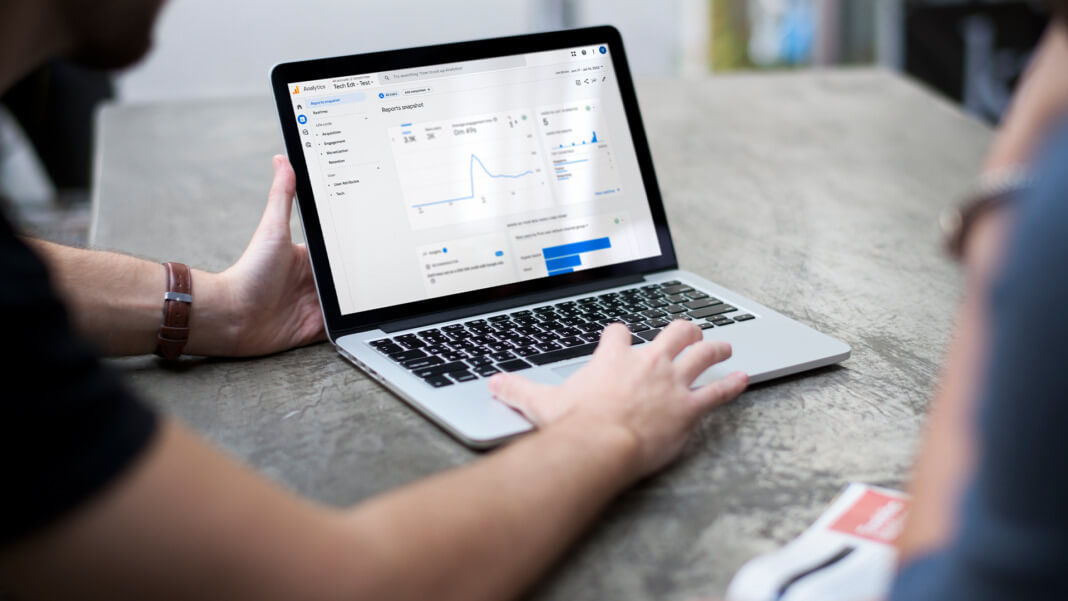The introduction of Google Analytics 4 (GA4) has ushered in a new era for digital marketers. With a reimagined interface, this analytical powerhouse offers features to deliver the most insightful and actionable data yet. GA4’s arrival is a game changer, not merely an update, but a complete rethinking of what Google Analytics can do for businesses. It provides more granular control, intelligent insights, and an enhanced focus on the user journey.
Whether you’re a seasoned pro or a newcomer to digital analytics, diving into GA4 can feel like stepping into uncharted territory. In this guide, we’ll navigate through the GA4 landscape, addressing common queries and exploring the powerful tools at your fingertips. This is a comprehensive guide that’ll help you understand and use Google Analytics 4, outlining how you can utilise its features to generate the most value from your data.
How to use Google Analytics 4
Q: How do I begin using Google Analytics 4?
Start by testing the new search bar. It lets you access instant answers for specific queries, such as “how many users this month vs last year”, specific reports or insights, property configuration, or to access the help content.
Q: What does the new Google Analytics 4 dashboard look like?
The new GA4 dashboard might initially seem familiar, but many reports differ from where they used to be. Explore this dashboard and familiarise yourself with the navigation menu, the different displays, and the reports dashboard.
Q: How can I find specific data like the number of people who viewed a particular page?
In the reports dashboard, click ‘Engagement’ and then look at the “Views by page title and screen class” chart. You can also view acquisition, monetisation, and user demographics here. To compare different metrics, select the + icon at the top to add a filter (next to ‘Engagement Overview’).
Q: Can I customise the reports snapshot?
Yes, one of the best features of GA4 is the ability to customise the reports snapshot. This allows you to see the data that matters most to you at a glance and will also help you become more comfortable with using GA4.
Q: How do I track events with Google Analytics 4?
In GA4, everything is considered an event, including page views, scrolls, and clicks. Go to the ‘Events’ tab on the left side of your dashboard. You can review all automatically collected events there or add a new event by clicking on ‘Create Event’.
Q: How can I use AI-powered insights in GA4?
AI-powered insights in GA4 can be accessed through the ‘Insights’ button, available in different places throughout the platform. These insights provide valuable information about data trends and predictive analytics.
Q: Can I track conversions in Google Analytics 4?
Yes, you can track conversions in GA4. Under the ‘Admin’ section, select ‘Conversions’. Here, you can mark any event as a conversion. This allows GA4 to track when users trigger these specific events.
Q: How do I use the funnels feature in GA4?
The funnels feature in GA4 can be accessed from the ‘Explorations’ tab. Click on ‘Explorations’, then select ‘Funnel Exploration’. This feature lets you map out the steps you want your users to take and then analyse how effectively users follow this path.
Q: How do I configure data settings in Google Analytics 4?
In GA4, you can configure data settings by going to ‘Data Settings’ under the ‘Admin’ tab. This includes managing your data streams, event tracking, conversions, and user-defined variables.
Q: What’s the best way to use the ‘Explore’ feature in Google Analytics 4?
The ‘Explore’ feature lets you delve deep into your data and create custom, detailed reports based on your unique needs. It provides templates like ‘Funnel Exploration’, ‘Path Exploration’, and ‘Segment Overlap’ to get you started. You can also create a blank report to customise your analysis fully.
Understanding the features of Google Analytics 4
Q: What are some of the key features of Google Analytics 4?
Several new features make Google Analytics 4 stand out from its predecessor. Here are a few:
- Machine Learning at its core: GA4 leverages Google’s advanced machine learning models to predict customers’ future actions. For example, it can help identify high-value customer segments.
- More granular data controls: GA4 allows you to manage how you collect, retain, and use your Analytics data. More granular controls for ads personalisation let you choose when to use your data to optimise your ads and limit data use based on user-centric considerations.
- Smarter insights: It helps you get insights about how many users are on your site and how they interact with your site. It focuses on visitor actions rather than just pageviews.
- Customer-centric data measurement: Instead of focusing on sessions or pageviews, GA4 centres around the customer. This provides a more holistic understanding of how customers interact with your business.
- Seamless integration with Google Ads: You can create audiences to reach your customers with more relevant, helpful experiences wherever they engage with your business.
- Codeless Event Tracking: With GA4, you no longer need to add code to your website to track events. You can set up conversions directly in the admin settings of your GA4 property.
Q: How does Google Analytics 4 improve the user experience?
GA4 is designed to give you the insights you need to improve your marketing ROI and deliver better user experiences. The focus is on customer-centric data, offering insights about customer behaviour across different devices and platforms. It also provides more intelligent, automated insights, making understanding and action your data easier.
Elevating Your data journey with GA4
Through exploring the capabilities of Google Analytics 4, we’ve journeyed deep into the data analytics landscape. GA4’s robust tools, intelligent insights, and user-centric features provide a rich terrain for marketers and business owners alike to venture into. A clear understanding of these tools allows you to create a data-driven roadmap to success in the intricate and ever-evolving digital world.
Utilising GA4’s tools, such as custom report snapshots, event tracking, AI-powered insights, and the funnels feature, allows for an elevated understanding of your audience’s behaviours. With this new knowledge, you can craft strategic, tailored marketing initiatives that resonate with your audience. And what’s more, GA4’s predictive power lets you not just react to the market trends but anticipate them, allowing you always to stay ahead.
Our exploration doesn’t end here. As you grow more accustomed to the interface and features of GA4, your understanding of your audience and their behaviours will deepen. With this newly harnessed knowledge, you will be well-equipped to take on the next leg of our journey: Migration and Reports in Google Analytics 4, which we will dive into in Part 3 of our guide.
From understanding how to smoothly transition your existing data to GA4 to gaining insights on utilising its advanced reporting features, we will delve into the nuances of these critical aspects. So, stay tuned for the next chapter of our GA4 expedition as we continue to decode the complexities of this powerful tool, enabling you to make the most of your data.





